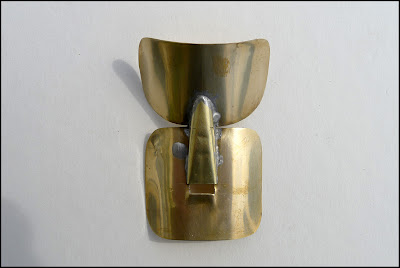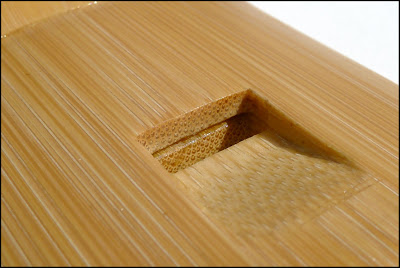The Humanaphone was a metal "all british" nose flute. The name must not be mixed up neither with Humanatone, nor with Humanophone, which was a « human organ » invented by Georges Ives, in which each person was commanded to sing only the same single note.
I don't know which year the Humanaphone was issued by, but it features as a novelty in the 1925 Keith Prowse & Co. catalog, London.
The Humanaphone was a tin nose flute, but it appears that there was also a celluloid version, more « hygienic », as it appears in the 1930 Jedson & Mastertone Musical catalog.
This blog is dedicated to the sublime instruments called nose flutes and which produce the most divine sound ever. We have chosen to discard all the native models from S. Pacific and Asia, for they need fingering to be played. We'll concentrate on "buccal cavity driven" nose flutes : the well patented and trademarked metal or plastic ones, plus, by a condemnable indulgence, some wooden craft or home-made productions.
Sep 9, 2011
Humanaphone : All British Make
Libellés :
archives,
Great Britain,
history,
Humanaphone,
metal,
plastics,
prices
Sep 8, 2011
Video : extreme playing!
Extreme ukulele and nasenflöte playing in Austria
Sep 7, 2011
Master Katada : the most creative among makers
Master Katada Kunio, a.k.a. Ki Kanban, is probably the most creative among the nose flute makers. Not only he is used to produce « hanabue » in a large range of materials, like wood, bamboo, copper, brass, tin plate, ... but he has also invented and designed numerous new shapes, from classical to modern. More, Katada-san is a researcher who drives experiments, notably in order to get the best dimensions in the technical parts of the nose flute.
But Kunio Katada is also a very generous man who reveals all what other would call secrets in his blog, sharing all the fabrication details.
So, yesterday morning, I received an incredible present from Master Katada : a sample box with no less than 12 nose flutes, very representative of the variety of his production. I was speechless...
The pack contains 3 bamboo flutes, 1 in what I suppose to be boxwood, one in copper, one in brass, 2 fancy in can tin, 2 in single wood and 2 in wood mix.
Mr. Katada sent me 3 different models. Two are made in a very smooth and regular bambo : one is a compact pebble and the other one has got an angled nose-cap.
The third one has a more « traditional » look, with its almost raw spotted bamboo, and using the node as a decorative line. This one is painted in green on its internal side.

This one has an incredible design. It's a thick wood slice, with a raw band of bark as a contour. One side is flat, showing the wood rings, and the other is a real ergonomic wood carving. Awesome.
There is a copper one, and a brass one. Both are made almost on the same design, but the brass one has got a shorter air-duct, thus forming a taller mouth-cap. The design of these flutes is incredible : absolutely « technical » (nothing superfluous), but at the same time in a pure Japanese design tradition. The very small oval nose air-hole, the air-duct, circular at one end, and tappered at the other, the curves and the angle... everything is perfectly drawn, and looks like an ikebana flower.
Those two are the fruit of an experiment by Master Katada. The deal was to make a flute with everyday life materials and simple tools, and thus, offering the possibility to everyone to build a nose flute « in the kitchen » (the template and technique was diffused on Ki Kanban's blog). Hence, those flutes are made on tin plate, a plastic straw for the air-duct, and then recovered by flower pattern thin fabric or a playing card.
I don't know which wood are these two flutes made of, but they are very light. The light color one is incredibly featherlight (19g). They are simple, but really well made, with a nice carving work in the inside.
The shape of those is quite the same than the single wood flutes one. But they use beautiful exotic woods. The « checkerboard » one is absolutely stunning, and offers amazing patterns when carved...
All the flutes by Katada Kunio are stamped with a « K », oftenly enhanced with a touch of red color.
Now, it is time to say that Master Katada is a « sensual engineer ». He is an engineer, because the technical part of his flutes is remarkably precise and well done. The air ducts are very thin, and the double cutaway labiums (labia?) are sharp and hard, leading to very precise and loud nose flutes.
But Master Katada's hanabue are also pure sensual objects. The ergonomic carving is doubled by a sharp « shape feeling ». The little instruments look like wooden pebbles in you hand.
Added to a special care given to the choice of the materials, and you understand why Mr. Katada is a master.
Just take a look (click to enlarge!):
For sure, the nose flutes by Katada Kunio sound very well...
[some sound samples will be posted quite soon]
Ki Kanban's blog (in Japanese)
Ki Kanban's blog (translated by Google Translate)
A previous post of this blog about Ki Kanban's blog
But Kunio Katada is also a very generous man who reveals all what other would call secrets in his blog, sharing all the fabrication details.
So, yesterday morning, I received an incredible present from Master Katada : a sample box with no less than 12 nose flutes, very representative of the variety of his production. I was speechless...
The pack contains 3 bamboo flutes, 1 in what I suppose to be boxwood, one in copper, one in brass, 2 fancy in can tin, 2 in single wood and 2 in wood mix.
The bamboo flutes
Mr. Katada sent me 3 different models. Two are made in a very smooth and regular bambo : one is a compact pebble and the other one has got an angled nose-cap.
The third one has a more « traditional » look, with its almost raw spotted bamboo, and using the node as a decorative line. This one is painted in green on its internal side.

 |  |
 | |
 |  |
 | |
 |  |
 | |
The Boxwood flute
This one has an incredible design. It's a thick wood slice, with a raw band of bark as a contour. One side is flat, showing the wood rings, and the other is a real ergonomic wood carving. Awesome.
 |  |
 | |
The metal flutes
There is a copper one, and a brass one. Both are made almost on the same design, but the brass one has got a shorter air-duct, thus forming a taller mouth-cap. The design of these flutes is incredible : absolutely « technical » (nothing superfluous), but at the same time in a pure Japanese design tradition. The very small oval nose air-hole, the air-duct, circular at one end, and tappered at the other, the curves and the angle... everything is perfectly drawn, and looks like an ikebana flower.
 | |
 |  |
 | |
 |  |
 | |
The fancy flutes
Those two are the fruit of an experiment by Master Katada. The deal was to make a flute with everyday life materials and simple tools, and thus, offering the possibility to everyone to build a nose flute « in the kitchen » (the template and technique was diffused on Ki Kanban's blog). Hence, those flutes are made on tin plate, a plastic straw for the air-duct, and then recovered by flower pattern thin fabric or a playing card.
 | |
 |  |
 |  |
The single wood flutes
I don't know which wood are these two flutes made of, but they are very light. The light color one is incredibly featherlight (19g). They are simple, but really well made, with a nice carving work in the inside.
 | |
 |  |
 | |
 |  |
 | |
The wood-mix flutes
The shape of those is quite the same than the single wood flutes one. But they use beautiful exotic woods. The « checkerboard » one is absolutely stunning, and offers amazing patterns when carved...
 |  |
 | |
 |  |
 | |
All the flutes by Katada Kunio are stamped with a « K », oftenly enhanced with a touch of red color.
Now, it is time to say that Master Katada is a « sensual engineer ». He is an engineer, because the technical part of his flutes is remarkably precise and well done. The air ducts are very thin, and the double cutaway labiums (labia?) are sharp and hard, leading to very precise and loud nose flutes.
 |  |
 |  |
 |  |
Added to a special care given to the choice of the materials, and you understand why Mr. Katada is a master.
Just take a look (click to enlarge!):
For sure, the nose flutes by Katada Kunio sound very well...
[some sound samples will be posted quite soon]
Ki Kanban's blog (in Japanese)
Ki Kanban's blog (translated by Google Translate)
A previous post of this blog about Ki Kanban's blog
Subscribe to:
Comments (Atom)











